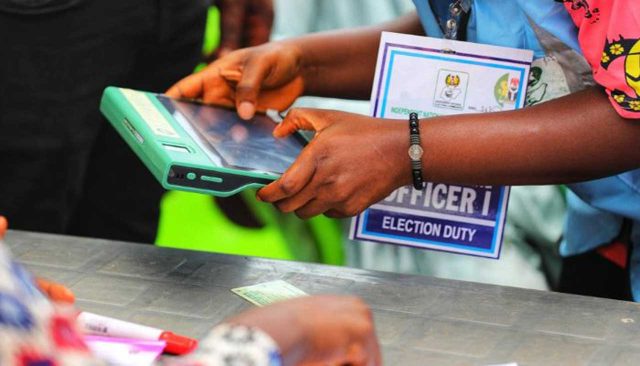The Federal High Court in Abuja, on Thursday, ordered the Independent National Electoral Commission to allow the use of Temporary Voter Cards in the forthcoming governorship and state houses of assembly elections which has been slated for March 18.
Two aggrieved Nigerians had filed a suit seeking the use of the Temporary Voter Card in the general elections in the absence of the Permanent Voter Cards.
The plaintiffs, Kofoworola Olusegun and Wilson Allwell, in the suit filed on February 8 and marked FHC/ABJ/CS/180/2023, challenged the position of INEC and asked the court to determine “whether a person whose name appears in the electronic format in INEC’s central database and manual, printed paper based record or hard copy format of the register of voters and has been assigned a Voter’s Identification Number can be said to be entitled to be accredited to vote with his/her TVC in the general election to be conducted by the defendant.”
The plaintiffs further requested the court to determine whether such a person can, as a consequence of INEC’s liabilities… omission be disenfranchised of the right and entitlement to vote in the 2023 general election.
Consequently, they prayed for the following reliefs should the questions be answered in their favour.
They asked for “a declaration that the plaintiff, having fulfilled all necessary legal requirements to register and having consequently been captured in its central database and manual, printed paper-based record or hard copy format of INEC’s maintained register of voters, the plaintiffs are entitled to vote using their TVC in the 2023 General Elections”.
Ruling, the court held that there was no portion of the law, both the 1999 Constitution and the Electoral Act that states that it is only PVCs that could be used, but that the law under Section 47 provided for a voter’s card.
Justice Egwuatu stated that the order was made on the grounds that the plaintiffs were duly registered and captured in INEC’s database.
He ruled that, “an order is made compelling the defendant to allow the plaintiffs to vote using their Temporary Voter Cards issued by the defendant, the plaintiffs having been duly captured in the National Register of Voters database”.
The judge further held that the plaintiffs are entitled to vote using their TVC in the forthcoming 2023 general election “having fulfilled all necessary legal requirements to register and having consequently been captured in INEC’s central database and manual, printed paper-based record or hard copy format”.
However, prayer 3 which was a request to allow every eligible voter with a TVC to vote was not granted.
“Any other order, the court may deem fit for all other Nigerians who are like the plaintiffs and have not gotten their permanent voter’s card, as the court may deem fit”
The judge held that the suit was not filed in a representative capacity.
The court maintained that, “This suit having not been brought in a representative capacity, I find myself unable to grant any relief pursuant to prayer three of the plaintiffs application.”
Speaking, counsel for the plaintiffs, Victor Opatola said that the judgement was a win for all Nigerians who suffered to get registered to vote, were duly registered but due to no fault of theirs could not get their PVCs before the election.
He said, “since my clients had fulfilled all necessary requirements by law but were not issued their PVCs until the time for collection of PVCs was over, they should not be allowed to suffer”.
The lawyer also said that it was the law of equity that what applied to the goose should also apply to the gander.
“So what the court is saying is that these two people who have fulfilled all necessary requirements can vote with their TVCs, then by law of equity, it should also apply to all Nigerians who have fulfilled all necessary requirements and were issued TVCs by INEC.”
Furthermore, he asserted that the content of the TVC was the same as the content of the PVC and the only difference was the plastic used for the PVC.
In this article

